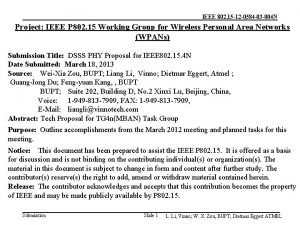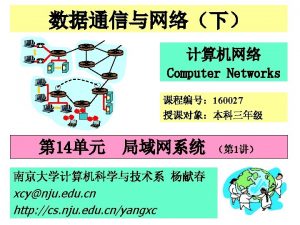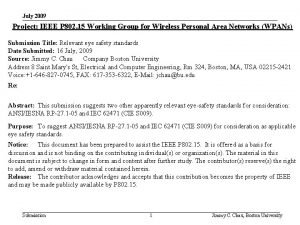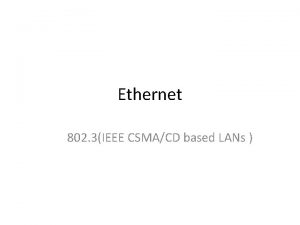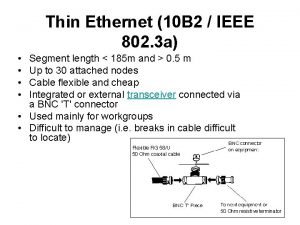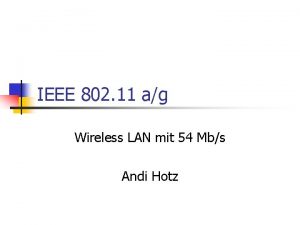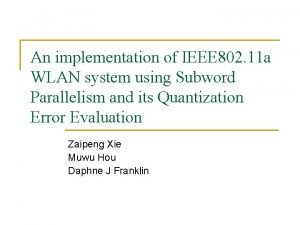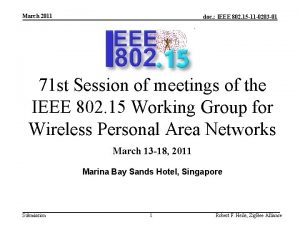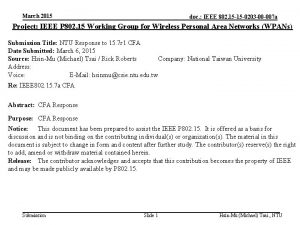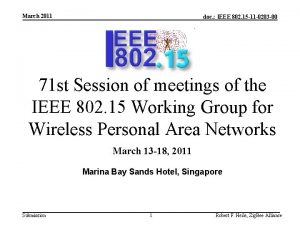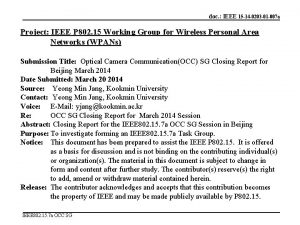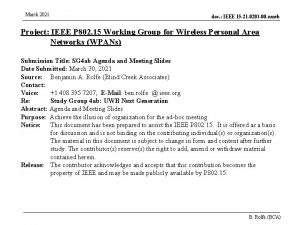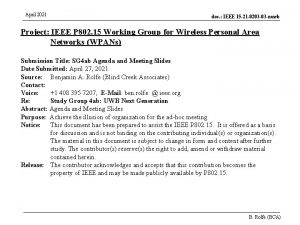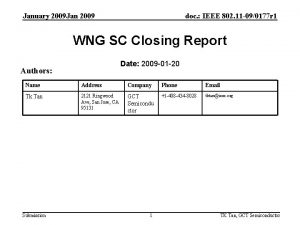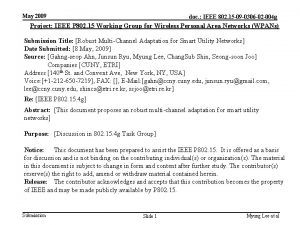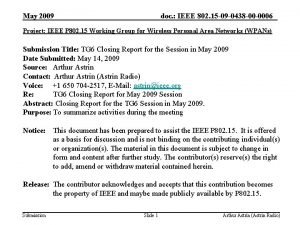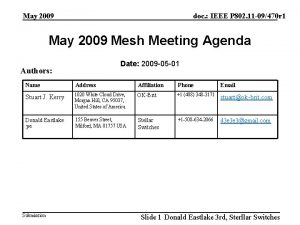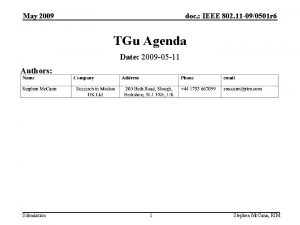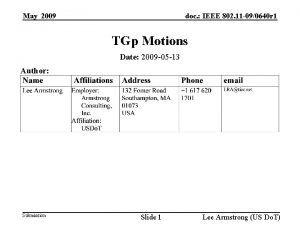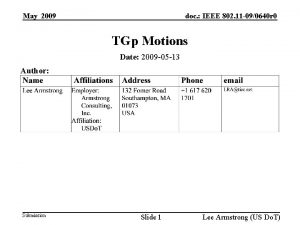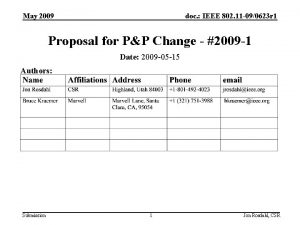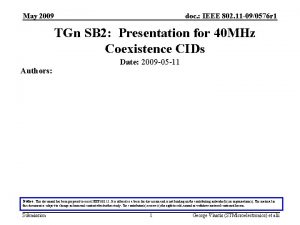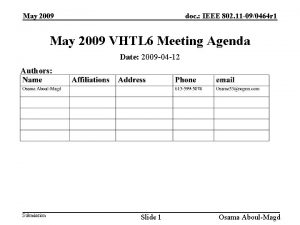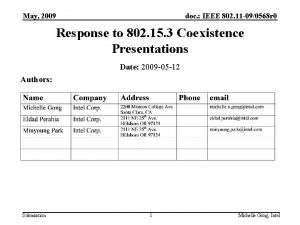May 2009 doc IEEE 802 15 09 0203





















- Slides: 21

May 2009 doc. : IEEE 802. 15 -09 -0203 -06 -004 f Project: IEEE P 802. 15 Working Group for Wireless Personal Area Networks (WPANs) Submission Title: [IEEE 802. 15. 4 f Key User and Technical Requirements] Date Submitted: [12 March 2009] Source: [Mike Mc. Innis] Company [The Boeing Company] Address [P. O. Box 3707, Mail Code 7 M-CA, Seattle, WA 98124 -2207, USA. ] E-Mail: [michael. d. mcinnis@boeing. com] Re : [] Abstract: [Key Requirements derived by IEEE 802. 15. 4 f Task Group March 2009 ] Purpose: [TG 4 f Working Document pertaining to Key User and Technical Requirements] Notice : This document has been prepared to assist the IEEE P 802. 15. It is offered as a basis for discussion and is not binding on the contributing individual(s) or organization(s). The material in this document is subject to change in form and content after further study. The contributor(s) reserve(s) the right to add, amend or withdraw material contained herein. Release: The contributor acknowledges and accepts that this contribution becomes the property of IEEE and may be made publicly available by P 802. 15. Submission IEEE 802. 15. 4 f Working Document

May 2009 doc. : IEEE 802. 15 -09 -0203 -06 -004 f Draft Key User Requirements and Technical Guidance Summary Submission IEEE 802. 15. 4 f Working Document

May 2009 doc. : IEEE 802. 15 -09 -0203 -06 -004 f Active RFID Tag Definition • An Active RFID tag is a device, typically attached to an asset or person, with a unique identification and the ability to produce its own radio signal not derived from an external radio signal. Active RFID tag applications include wireless sensor telemetry, control, and location determination. To generate a radio signal, Active RFID tags must employ some source of energy. Traditionally this has been accomplished by integrated batteries, although designs exist for such devices that harvest ambient energy from the surrounding environment. Submission IEEE 802. 15. 4 f Working Document

802. 15. 4 f User Requirements Summary May 2009 • • Must have optional capability to provide another unique ID Regulatory compatibility – – • Low latency between when the event occurs and when it is recognized on the other end Mobility (roaming between readers) Total Cost of Ownership (TCO) Range – – • Tag does not require every optional feature and functionality Real Time – • • • Per reader Minimum cost tag (baseline) – • Including extreme RF environments Sensor integration requirement (optional) High tag density – • Methods to conserve battery energy (low energy use) Option to control tag Indoor and outdoor use – • • Precision Presence Portal, Choke point, sign post Baseline tag with capability to add optional features Tag power management – • • Regional Global Tag location capability – – – • • doc. : IEEE 802. 15 -09 -0203 -06 -004 f Line of Sight (LOS) Non-Line of Sight (NLOS) Electromagnetic non-interference with other electronic devices – Submission Example: implantable devices IEEE 802. 15. 4 f Working Document

802. 15. 4 f Technical Requirements Summary May 2009 ü ü ü ü doc. : IEEE 802. 15 -09 -0203 -06 -004 f Utilize 802. 15. 4 MAC Every tag/device has a 64 bit MAC address – Must have optional capability to provide another unique ID Regulatory compatibility – Regional – Global Tag location capability – Precision – Presence – Portal, Choke point, sign post Baseline tag with capability to add optional features Tag power management – Methods to conserve battery energy (low energy use) Option to control tag (covered under baseline tag options and optional two-way communications) Indoor and outdoor use – Including extreme RF environments Sensor integration requirement (optional) (covered under baseline tag options and ability to support a unique ID) – Variable Packet Data Unit payload size (capable of between x to y bytes of information) High tag density – Per reader Minimum cost tag (baseline) – Tag does not require every optional feature and functionality Real Time – Low latency between when the event occurs and when it is recognized on the other end Mobility (roaming between readers) (changed to 802. 15. 4 MAC Requirements) Range (changed to Maximum Transmitter Power in lieu of discussing ‘range’) – Line of Sight (LOS) – Non-Line of Sight (NLOS) Electromagnetic non-interference with other electronic devices Submission IEEE 802. 15. 4 f Working Document

May 2009 doc. : IEEE 802. 15 -09 -0203 -06 -004 f Utilize 802. 15. 4 MAC • Starting point • Make changes necessary to the 802. 15. 4 MAC required to support new PHY(s) • Desire is to avoid making, or to make only minimum, changes to the MAC • Compatibility with IEEE 802 hierarchy 802. 1(? ) Submission IEEE 802. 15. 4 f Working Document

May 2009 doc. : IEEE 802. 15 -09 -0203 -06 -004 f Capability to provide optional secondary ID • Optional • Variable up to 35 characters - Maximum – 35 characters x 6 bits (largest known to date per a NATO STANAG) Submission IEEE 802. 15. 4 f Working Document

May 2009 doc. : IEEE 802. 15 -09 -0203 -06 -004 f Regulatory Compatibility • Indoor or/and outdoor • UWB Band (Band plan to include global use) Known regulatory requirements are listed below. – Korea* – – Japan ARIB STD –T 91 Canada* – – China – draft state Europe* • • – – • ETSI EN 302. 500 (location std) ETSI EN 302. 065 (Communication std) 15. 250 (U. S. Wideband regulations) 15. 519 (U. S. Handheld UWB regulations) 15. 517 (U. S. indoor UWB regulations) Singapore* New Zealand* Other 2. 4 GHz Band – – – • RSS 220 Australia United States* • • • – – – Korea Communications Commission 2008 -033 15. 247 (U. S. ISM regulations) 15. 249 ETSI EN 300 440 ARIB (Japan) Other Sub-GHz Band (433. 92 MHz ? ) – – Submission – 15. 231 15. 209 15. 240 Japan ARIB STD –T 89 and -T 90 Other IEEE 802. 15. 4 f Working Document

May 2009 doc. : IEEE 802. 15 -09 -0203 -06 -004 f Tag location capability • Position – Defined in 2 or 3 dimensions – Precision of tag position – Sub 1 meter – Sub 3 meter – Sub 10 meter • Presence (Reader location) – A tag within the read range or coverage zone of at least one reader Submission IEEE 802. 15. 4 f Working Document

May 2009 doc. : IEEE 802. 15 -09 -0203 -06 -004 f Tag Features • Baseline – MAC (see MAC slide) – Transmitter • Modulation Scheme that can be demodulated by both a coherent and non-coherent receiver. – Coexistence with IEEE 802 family • • – • Depending on the transmitter PHY utilized, a receiver function may be required Definition: – "A state of acceptable co-channel and/or adjacent channel operation of two or more radio systems (possibly using different wireless access technologies) within the same geographical area. " Ability to produce its own radio signal not derived from an external radio signal Optional features – Two-way communications – Example payloads supported – E. g. Secondary ID, Battery status, Sensor, Event occurrence, etc Submission IEEE 802. 15. 4 f Working Document

May 2009 doc. : IEEE 802. 15 -09 -0203 -06 -004 f Tag power management • Low energy use – Examples • • • Submission Sleep mode Duty Cycle Low blink rate Variable packet data frame size Variable transmitter power Etc. IEEE 802. 15. 4 f Working Document

May 2009 doc. : IEEE 802. 15 -09 -0203 -06 -004 f Maximum Transmitter Power • IN LIEU OF THE DISCUSSION ON RANGE REQUIREMENTS • Per spectrum regulations for each country • A variety of RF transmitter powers are acceptable and may result in various class types to accommodate. Submission IEEE 802. 15. 4 f Working Document

May 2009 doc. : IEEE 802. 15 -09 -0203 -06 -004 f Device Classification • Multiple class vs single class of devices? • Do we want to have ‘classes’ of devices? – If so What attributes define a class of device? – Solicit through CFP? • • RF transmitter power Energy consumption (battery life) Baseline Tag Data rate Uni-directional or bi-directional communication Frequency band Modulation Regional vs global devices – Common PHY and channel for global devices? • • Indoor or/and outdoor Realtime Submission IEEE 802. 15. 4 f Working Document

May 2009 doc. : IEEE 802. 15 -09 -0203 -06 -004 f Electromagnetic non-interference with other electronic devices • Must meet IEEE 802 coexistence requirements – An IEEE 802 coexistence document/exhibit is required from 802. 15. 4 f to 802. 19. • Must meet in-country regulatory requirements Submission IEEE 802. 15. 4 f Working Document

May 2009 doc. : IEEE 802. 15 -09 -0203 -06 -004 f 802. 15. 4 MAC Requirements • Define and resolve any issues with 802. 15. 4 MAC – Tag Multicast / Broadcast • Simultaneous reception and processing of tag transmissions by multiple readers is not currently supported in the 802. 15. 4 MAC. – Data Payload Indicator • Indication whether data payload is present – If a data payload is indicated then; • Variable data payload size capability – Transmit Only • Device transmit without association • Research 15. 4 a UWB Clear Channel Assessment feature Clause 6. 9. 9 Submission IEEE 802. 15. 4 f Working Document

May 2009 doc. : IEEE 802. 15 -09 -0203 -06 -004 f Indoor and Outdoor Use • Including extreme RF environments – Outdoor • Weather rain, fog, snow, (moisture) and PHY selection • Multipath – Review currently available channel models – Indoor • Multipath – Review currently available channel models • Seamless tag handover between indoor and outdoor systems – Same PHY to same PHY – One PHY to another PHY Submission IEEE 802. 15. 4 f Working Document

May 2009 doc. : IEEE 802. 15 -09 -0203 -06 -004 f High Tag Density Per Reader – Number of tag transactions per second per reader – – – Uni-directional Bi-directional Data rate Beacon rate Modulation scheme PHY frame size – Proposer will provide the number of tag transactions per second which their proposal is capable of. • The goal is to maximize tag transactions per second. – – Submission Blink rate Range Location accuracy Tag population per reader IEEE 802. 15. 4 f Working Document

May 2009 doc. : IEEE 802. 15 -09 -0203 -06 -004 f Real Time • Low latency between when the event occurs and when it is recognized on the other end. – Data rate – Packet size • MAC layer overhead • How frequently the tag transmits or communicates – Blink rate Submission IEEE 802. 15. 4 f Working Document

May 2009 doc. : IEEE 802. 15 -09 -0203 -06 -004 f Misc. – Tag motion and speed • Doppler affects the PHY modulation selection – Something in the PHY packet which enables location determination. • For example (some, all, or other) – TOA – AOA – Receive Signal Strength (RSS) – Informative annex of example location methods Submission IEEE 802. 15. 4 f Working Document

May 2009 doc. : IEEE 802. 15 -09 -0203 -06 -004 f PHY(s) Parameters • • • Operating band(s) (band/channel plan) Modulation and Coding Scheme(s) PPDU structure (e. g. preamble, SFD, length, codes) – Suggestions • • • Synchronization and Timing Bit Rate, Symbol Rate, Chip Rate (as appropriate) Transmitter characteristics – – • • • Power Spectral Density (PSD) Mask (in band, out of band) Transmit Power Duty Cycle Peak to average ratio (where applicable) RSSI and/or Link Quality Indicator methods Reliability enhancing features/methods Co-existence mechanisms Link Budget Timing sensitivity (tag to reader) • • Short header Short preamble i. e. pulse-to-pulse timing, packet-to-packet timing, etc. Blink rate variability min-max – Submission In defined steps IEEE 802. 15. 4 f Working Document

May 2009 doc. : IEEE 802. 15 -09 -0203 -06 -004 f Differentiation of PHY Characteristics from other IEEE 802 PHYs • Can take advantage of PHY channel bandwidths which are narrower or wider than current defined 802 PHYs • Very low energy consumption (enable energy harvesting) • Very high number of devices • Can take advantage of minimal IEEE 802. 15. 4 MAC features Submission IEEE 802. 15. 4 f Working Document
 Osvedčenie požiarnej konštrukcie
Osvedčenie požiarnej konštrukcie Bridges from 802.x to 802.y
Bridges from 802.x to 802.y Bridges from 802.x to 802.y
Bridges from 802.x to 802.y Ieee 802 standard
Ieee 802 standard 802 15
802 15 802 ieee
802 ieee Ieee 802
Ieee 802 Ieee 802 family
Ieee 802 family Ieee 802 3 compliance
Ieee 802 3 compliance Ieee 802
Ieee 802 Arquitetura ieee 802
Arquitetura ieee 802 Estandares ieee 802
Estandares ieee 802 Hci patterns may or may not include code for implementation
Hci patterns may or may not include code for implementation 802 15
802 15 802 protocols
802 protocols Ccna 640-802
Ccna 640-802 09 802 0561
09 802 0561 Ethernet 802
Ethernet 802 802-3-ethernet
802-3-ethernet 802 701
802 701 Wireless lan 802
Wireless lan 802 Wlan 802
Wlan 802













